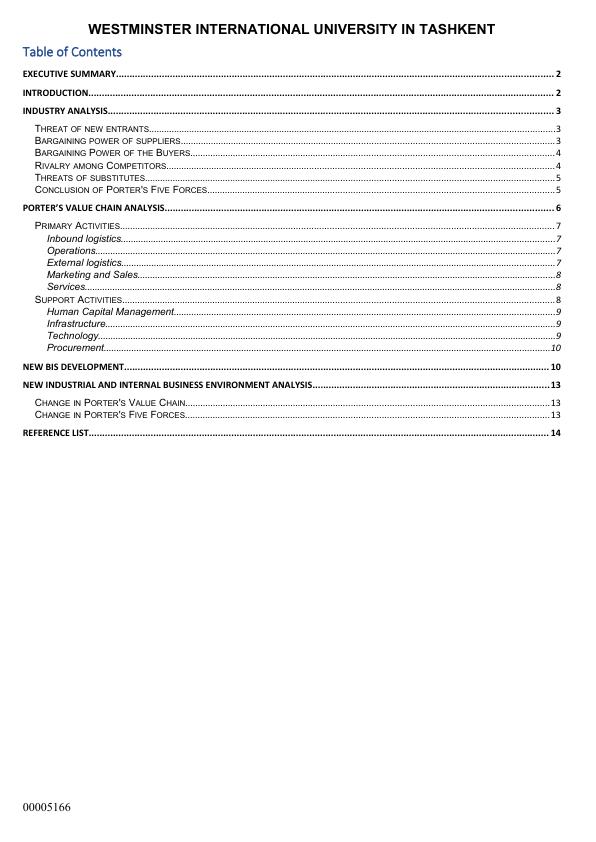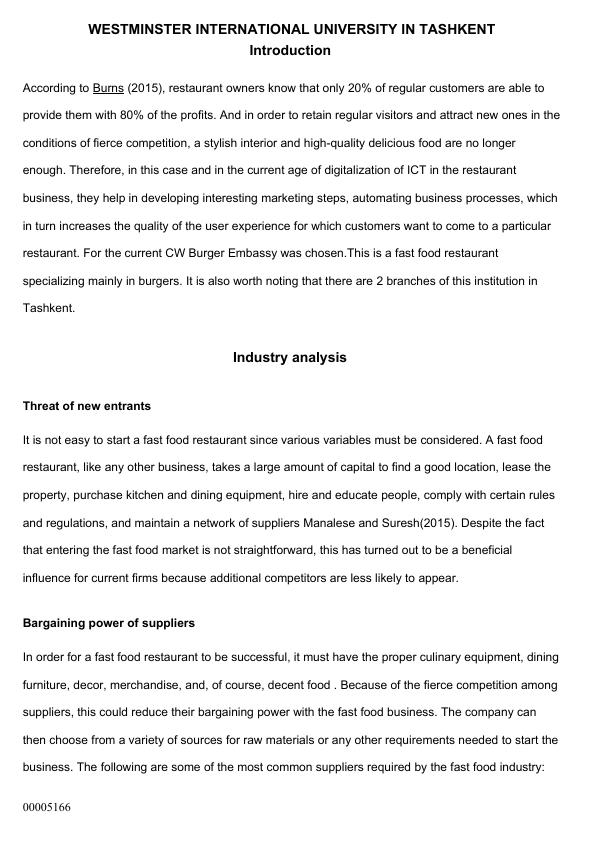SUBMISSION FOR THE SUBMISSION OF A COURSEWORK FOR FIRST MARKER'S AND ENTEPrise
Westminster International University in Tashkent
Added on 2022-03-25
About This Document
Burns (2015) cites a study indicating that restaurant owners typically make 80% of their profits from 20% of regular clients. It is not enough to have a stylish interior and delicious food to retain regular visitors and attract new ones in such a competitive environment. This means that, in this case, and in the current age of digitalization in the restaurant business, ICT plays an important role in creating interesting marketing strategies and automating business processes, which contribute to the high quality of the restaurant's user experience that consistently attracts customers.
SUBMISSION FOR THE SUBMISSION OF A COURSEWORK FOR FIRST MARKER'S AND ENTEPrise
Westminster International University in Tashkent
Added on 2022-03-25
COURSEWORK SUBMISSION FORM
STUDENT USE STAFF USE
Module Name Developing Digital
Enterprise
First Marker’s
(acts as signature)
Module Code 6COSC013C Second Marker’s
(acts as signature)
Lecturer Name Abdumalik Djumanov Agreed Mark
UoW Student IDs For Registrar’s office use only (hard copy
submission)
WIUT Student IDs 00005166
Deadline date
Assignment Type Individual
SUBMISSION INSTRUCTIONS
COURSEWORKS must be submitted in both HARD COPY (to the Registrar’s Office) and
ELECTRONIC unless instructed otherwise.
For hardcopy submission instructions refer to:
http://intranet.wiut.uz/Shared%20Documents/Forms/AllItems.aspx - Coursework hard copy
submission instructions.doc
For online submission instructions refer to:
http://intranet.wiut.uz/Shared%20Documents/Forms/AllItems.aspx - Coursework online submission
instructions.doc
MARKERS FEEDBACK (Continued on the next page)
00005166

Table of Contents
EXECUTIVE SUMMARY.................................................................................................................................................................. 2
INTRODUCTION............................................................................................................................................................................. 2
INDUSTRY ANALYSIS..................................................................................................................................................................... 3
THREAT OF NEW ENTRANTS..................................................................................................................................................................3
BARGAINING POWER OF SUPPLIERS...................................................................................................................................................3
BARGAINING POWER OF THE BUYERS...............................................................................................................................................4
RIVALRY AMONG COMPETITORS........................................................................................................................................................4
THREATS OF SUBSTITUTES.................................................................................................................................................................5
CONCLUSION OF PORTER'S FIVE FORCES........................................................................................................................................5
PORTER’S VALUE CHAIN ANALYSIS................................................................................................................................................ 6
PRIMARY ACTIVITIES.......................................................................................................................................................................... 7
Inbound logistics.............................................................................................................................................................................7
Operations........................................................................................................................................................................................7
External logistics.............................................................................................................................................................................7
Marketing and Sales.......................................................................................................................................................................8
Services............................................................................................................................................................................................8
SUPPORT ACTIVITIES..........................................................................................................................................................................8
Human Capital Management........................................................................................................................................................9
Infrastructure....................................................................................................................................................................................9
Technology.......................................................................................................................................................................................9
Procurement..................................................................................................................................................................................10
NEW BIS DEVELOPMENT.............................................................................................................................................................. 10
NEW INDUSTRIAL AND INTERNAL BUSINESS ENVIRONMENT ANALYSIS........................................................................................13
CHANGE IN PORTER'S VALUE CHAIN...............................................................................................................................................13
CHANGE IN PORTER'S FIVE FORCES...............................................................................................................................................13
REFERENCE LIST........................................................................................................................................................................... 14
00005166

Executive summary
This report is devoted to how the implementation of ICT is reengineering business processes along
with the improvement of the company's competitiveness. Also it is worth noting that in the first place
an analysis of the industry was carried out, namely Porter's 5 forces in the restaurant industry,
because the subject of the analysis is the Burger Embasia company. From the analysis it was found
out that the main threats to the company are Existing Competitors, Buyers and New Entrants.
Porter's value chain analysis identifies both primary and supportive activities of a company that affect
its operations and income. This includes inbound logistics, operations, outbound logistics, marketing,
sales and service, while the support team includes firm infrastructure, human resources, technology
development, and procurement. After conducting the above 2 analyzes, it was decided to implement
a mobile food delivery application with unique features such as the ability to track the courier on the
map. This, in turn, will have a positive impact on the company's activities, namely, it will affect , cost
reduction, increase competitiveness through differentiation and tie customers to the company. Thus,
the threats that have been identified will become insignificant with the introduction of ICT. It will also
enable the organization to focus on the quality of services that were pointed out in the value chain's
primary activities, as well as to speed up internal operations.
00005166

Introduction
According to Burns (2015), restaurant owners know that only 20% of regular customers are able to
provide them with 80% of the profits. And in order to retain regular visitors and attract new ones in the
conditions of fierce competition, a stylish interior and high-quality delicious food are no longer
enough. Therefore, in this case and in the current age of digitalization of ICT in the restaurant
business, they help in developing interesting marketing steps, automating business processes, which
in turn increases the quality of the user experience for which customers want to come to a particular
restaurant. For the current CW Burger Embassy was chosen.This is a fast food restaurant
specializing mainly in burgers. It is also worth noting that there are 2 branches of this institution in
Tashkent.
Industry analysis
Threat of new entrants
It is not easy to start a fast food restaurant since various variables must be considered. A fast food
restaurant, like any other business, takes a large amount of capital to find a good location, lease the
property, purchase kitchen and dining equipment, hire and educate people, comply with certain rules
and regulations, and maintain a network of suppliers Manalese and Suresh(2015). Despite the fact
that entering the fast food market is not straightforward, this has turned out to be a beneficial
influence for current firms because additional competitors are less likely to appear.
Bargaining power of suppliers
In order for a fast food restaurant to be successful, it must have the proper culinary equipment, dining
furniture, decor, merchandise, and, of course, decent food . Because of the fierce competition among
suppliers, this could reduce their bargaining power with the fast food business. The company can
then choose from a variety of sources for raw materials or any other requirements needed to start the
business. The following are some of the most common suppliers required by the fast food industry:
00005166

End of preview
Want to access all the pages? Upload your documents or become a member.
